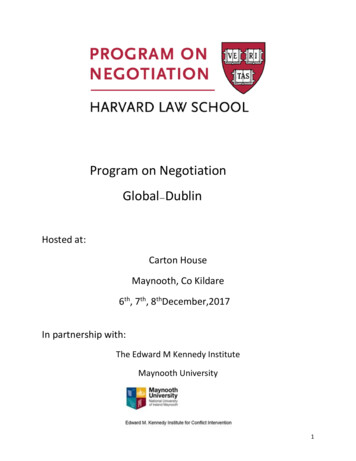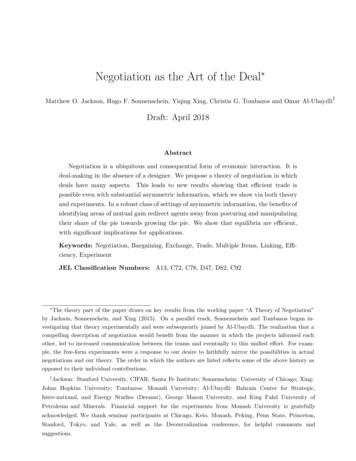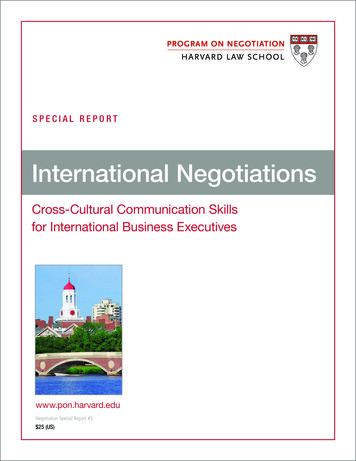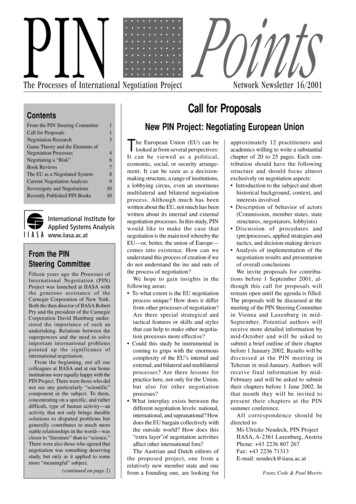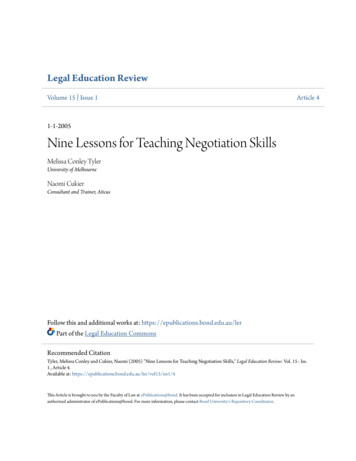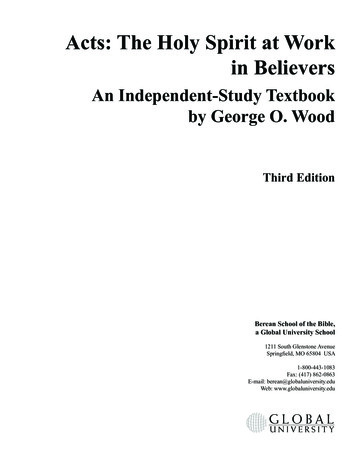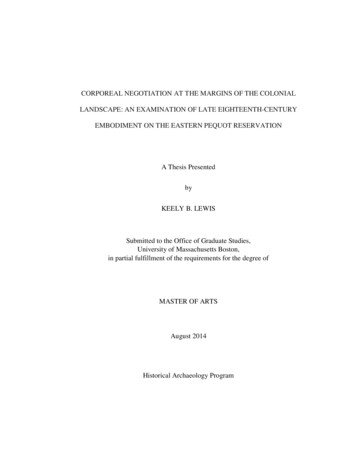
Transcription
CORPOREAL NEGOTIATION AT THE MARGINS OF THE COLONIALLANDSCAPE: AN EXAMINATION OF LATE EIGHTEENTH-CENTURYEMBODIMENT ON THE EASTERN PEQUOT RESERVATIONA Thesis PresentedbyKEELY B. LEWISSubmitted to the Office of Graduate Studies,University of Massachusetts Boston,in partial fulfillment of the requirements for the degree ofMASTER OF ARTSAugust 2014Historical Archaeology Program
2014 by Keely B. LewisAll rights reserved
CORPOREAL NEGOTIATION AT THE MARGINS OF THE COLONIALLANDSCAPE: AN EXAMINATION OF LATE EIGHTEENTH-CENTURYEMBODIMENT ON THE EASTERN PEQUOT RESERVATIONA Thesis PresentedbyKEELY B. LEWISApproved as to style and content by:Stephen W. Silliman, ProfessorChairperson of CommitteePing-Ann Addo, Associate ProfessorMemberDiana Loren, Director of Academic Partnerships and Museum Curator, PeabodyMuseum of Archaeology and Ethnology, Harvard University,MemberStephen W. Silliman, Program DirectorHistorical Archaeology ProgramJudith F. Zeitlin, ChairpersonDepartment of Anthropology
ABSTRACTCORPOREAL NEGOTIATION AT THE MARGINS OF THE COLONIALLANDSCAPE: AN EXAMINATION OF LATE EIGHTEENTH-CENTURYEMBODIMENT ON THE EASTERN PEQUOT RESERVATIONAugust 2014Keely B. Lewis, B.A., University of South CarolinaM.A., University of Massachusetts BostonDirected by Professor Stephen W. SillimanDuring the forming of the early republic in late colonial New England, Angloauthors and intellectuals employed the literary device of othering in their work, castingNative Americans as the antithesis of “civilized” English culture in order to assert theirown modernity and foster burgeoning nationalism. In colonial literature, as in the colonialworld, the body was the platform where these racial and cultural differences werepronounced with depictions of skin color and dress being central to reinforcing politicallyexpedient notions of cultural otherness. As Native Americans in southern New Englandduring this period were rarely depicted in the historical record, and the fewrepresentations that exist were often skewed by this colonial bias, the artifacts of dressthey left behind provide an outlet to reconstruct a more accurate sketch of their visiblepresence in the past.iv
This thesis examines assemblages of dress and adornment from five EasternPequot households on the Lantern Hill Reservation in North Stonington, Connecticut,spanning the mid-eighteenth to early nineteenth century. With a focus on how individualsin these households expressed and performed their social identities through outwarddisplay, I offer a textured understanding of the appearance of Eastern Pequot peopleacross households and decades. I draw on a combination of material culture studies,social theory, and critical materialism in a discussion of embodiment and the negotiationof identity in the colonial and early modern context. The material variation and spatialdistribution of these artifacts across each site is examined, revealing the patterns of theiruse and disposal. These data are employed to determine how the distinct assemblagesreflect individual consumption and affiliation as well as changes in the demography ofthe reservation community, restricted market connections, and overarching local andregional conditions.This project shows that gender, occupation, trends in fashion, and economicaccess converged with ethnicity in the processes of identity negotiation at the fivehouseholds. By selectively incorporating manufactured clothing and adornment into theirdaily practice while maintaining their individuality, members of the Eastern Pequotcommunity refused the notion pushed by colonial authors that they could never bemodern, while simultaneously maintaining strong connections to their heritage.v
ACKNOWLEDGEMENTSI would like to thank, first and foremost, the Eastern Pequot Tribal Council forallowing me to conduct this research and for supporting the collaborative archaeologicalproject that made it possible. My time spent on the project was an unforgettable learningexperience that inspired my work and deepened my understanding of what archaeologycan and should accomplish. The opportunity to work alongside Bobby Sebastian,Natasha Gambrell, Ashbow Sebastian, and all of the other Eastern Pequot volunteers andvisitors truly enriched the output of this research. My deepest gratitude as well to mycommittee chair, Dr. Stephen Silliman, for his invaluable insight, guidance, andencouragement that made the completion of this thesis possible; to my committeemembers Dr. Ping-Ann Addo and Dr. Diana Loren, for their thoughtful feedback thatinspired me and enhanced this work; to my labmates in the Eastern Pequot laboratory fortheir continual help, support, and advice; and to my cohort for always being there for amuch-needed writing break. Lastly, my heartfelt thanks to my network of family andfriends who have always pushed me to pursue my dreams, no matter how far from homethey have taken me; your words of wisdom carried me throughout this process and Icould not have done this without you as a constant source of motivation.vi
TABLE OF CONTENTSACKNOWLEDGMENTS .viLIST OF FIGURES .ixLIST OF TABLES .xCHAPTERPage1. INTRODUCTION .Research Problem .Outline of Chapters .1482. INDIVIDUALITY, IDENTITY AND CONSUMPTION:THEORETICAL PERSPECTIVES ON EMBODIMENT .Importance of an Interdisciplinary Approach .Divisions of Individuality .Negotiating the Colonial Body .Consuming Identity.Lens of Embodiment .1011131620223. HISTORICAL AND SOCIAL SETTING .Long-Term History .Early Colonial Survival.Holding On To Their Homeland .The Eastern Pequot in the Early Republic .Clothing, Consumption and Native Identity .2425283033424. PROJECT BACKGROUND AND ARCHAEOLOGICALEXCAVATIONS .Site Backgrounds .Site 102-124 .Site 102-123 .Site 102-126 .Site 102-125 .Site 102-82 .Archaeological Methods .Methods of Analysis .5052535556585960625. SITE ASSEMBLAGES AND DATA .Clothing Fasteners .Buckles .656667vii
CHAPTERPageButtons .Hooks and Eyes.Jewelry .Beads .Pendants .Rings .Glass Pastes .Hair Accessories .Hair Ornaments .Miscellaneous Accessories .Chains .Artifacts of Needlework and Sewing .Straight Pins .Thimbles .Shears and Scissors .Articles of Textile Production .Summary of the Site Assemblages .68707172737475767677787980818283846. SPATIAL INTERPRETATIONS .Mid-Eighteenth Century .Late Eighteenth Century .Early Nineteenth Century .Summary of Spatial and Material Variation .858588981037. TEMPORAL AND CORPOREAL NEGOTATION.Conclusions on Embodiment .105115REFERENCES .120viii
LIST OF FIGURESFigurePage1. Map of northeastern North America, showing location ofEastern Pequot Reservation in North Stonington,Connecticut .62. Artifact Categories by Site .663. Clothing Fasteners from Sites Examined .674. Various Beads from Sites Examined .725. Hair Ornament from Site 102-123 .766. Chain Fragments from Site 102-82 .787. Straight Pins from Site 102-124 .798. Site 102-124 Natural Neighbor Analysis of Artifacts ofAdornment and Dress .869. Site 102-123 Natural Neighbor Analysis of Artifacts ofAdornment and Dress .8910. Site 102-126 Natural Neighbor Analysis of Artifacts ofAdornment and Dress .9311. Site 102-125 Natural Neighbor Analysis of Artifacts ofAdornment and Dress .9712. Site 102-82 Natural Neighbor Analysis of Artifacts ofAdornment and Dress .10013. Site 102-124 Representative Assemblage .10714. Site 102-123 Representative Assemblage .10915. Site 102-126 Representative Assemblage .11116. Site 102-125 Representative Assemblage .11217. Site 102-82 Representative Assemblage .114ix
LIST OF TABLESTablePage1. Recovery of Artifacts of Adornment and Dress at each Site .612. Adornment and Dress Categories by Site .633. Categories of Personal Adornment and Dress Artifacts Examined634. Percentage of Overall Excavation Units with Personal AdornmentAnd Dress Artifacts.645. Dates of Occupation for Sites Examined .666. Site 102-124 Assemblage by Category and Type .887. Site 102-123 Assemblage by Category and Type .928. Site 102-126 Assemblage by Category and Type .949. Site 102-125 Assemblage by Category and Type .9810. Site 102-82 Assemblage by Category and Type .10111. Percentage of Personal Adornment Artifacts fromHeavy Fraction .103x
CHAPTER 1INTRODUCTIONThe whole body of these Indians are a poor, degraded miserable race ofbeings To these remarks there are some exceptions. The women, wholive in English families, retain at times a degree of that fondness for dress,so remarkable and universal among such as still continue in a savage state(Dwight 1823:19-21).The master narrative of New England was that it had made a stark breakwith the past, replacing “uncivilized” peoples whose histories and culturesthey represented as illogically rooted in nature, tradition and superstition,whereas New Englanders symbolized the “civilized” order of culture,science, and reason. Modernity is predicated on exactly this sort of rupture(O’Brien 2010:xxi).In the summer of 1807, Yale University president and archconservativetheologian Timothy Dwight visited Stonington, Connecticut, during his travels throughNew York and New England. In a letter he wrote recounting the visit and hisobservations, Dwight briefly describes the landscape of Stonington before addressing the“degraded character and situation” of the Eastern Pequot residing on their reservationwithin the township (Dwight 1823:15). Dwight, who had previously authored the epicpoem Greenfield Hill (1794) celebrating a markedly one-sided account of the “Pequotconquest,” scornfully yet nostalgically declared that “The former proud, heroic spirit ofthe Pequot, terrible even to other proud, heroic spirits around him, is shrunk into thetameness and torpor of reasoning brutism” (Dwight 1823:19). Dwight goes on in theletter to expand his observations about the Eastern Pequot to all of the tribes residing in1
New England, explicitly casting Indians as the antithesis of “civilized man,” going as faras to argue that “This position is completely proved by the fact, that the children ofAmericans, Englishmen, Scotchmen, Irishmen, Dutchmen, and Frenchmen, whencaptivated by them in early life, become mere Indians, distinguishable in nothing, excepta small difference of colour, from the native savages” (Dwight 1823:23).Historians and anthropologists have argued that Dwight, and other Americanintellectuals in late colonial New England, employed the device of “othering” in theirwork to foster a sense of nationalism during the forming of the early republic (DenOuden 2005; Kornfeld 1995; O’Brien 2010; Said 1993). In early America, the image ofthe Indian was central to this discourse, and authors such as Dwight relied uponprojecting a “flattened, reduced, simplified, and frozen” portrait of “Indian savagery” inorder to propagate burgeoning imperialist ideals of the era and assert their own modernity(Den Ouden 2005; Kornfeld 1995:290). Deconstructing the opposition set up by thiscolonial discourse reveals that American intellectuals “constructed a naturalized savageOther, devoid of cultural complexity, integrity and history” in order to define andlegitimize their own cultural identity (Kornfeld 1995:291). The rhetorical power gainedfrom this binary was fundamental to the naturalization of colonial power and dominationin southern New England, silencing the narratives of struggle in Native communities,denying Native resistance to colonial control, and justifying the dispossession of Nativeland (Den Ouden 2005; Kornfeld 1995).In adherence to this convention, Dwight makes explicit his construction of theEastern Pequot as the “savage” Other, in opposition to the “civilized man”, detailing whathe perceives as their moral downfalls and failure to adhere to the mechanisms of a civil2
society. In an interesting caveat to his remarks, Dwight (1823:21) adds “there are someexceptions. The women, who live in English families, retain at times a degree of thatfondness for dress, so remarkable and universal among such as still continue in a savagestate.” In this statement, Dwight equates civility with dress, inextricably linking the twoin his suggestion that Otherness can be obscured by one’s outward appearance. Dwightreiterates this idea throughout his letter when he describes the Eastern Pequot “savage” as“half-naked” (Dwight 1823:20), dressing himself “in a blanket” (Dwight 1823:24) and,again, when he contends that a child of any nationality “when captivated by them in earlylife, become mere Indians, distinguishable in nothing, except a small difference ofcolour” (Dwight1823:23). In all of these statements the focus is on the outwardappearance of the Other as Dwight purposefully projects and reinforces ideas about“Indianness” that were part of the larger colonial discourse (Den Ouden 2005:9). Hischaracterizations draw on the Anglo-Saxon tradition of measuring civility in terms of“proper” dress and coding nakedness with immorality and indecency (Brooke 1958;Loren 2008; Roche 1994). Dwight’s words reveal how the visible ethnicity of the EasternPequot, and other Native Americans in southern New England, was socially constructedby authors of the late colonial period, emerging only in its contrast to the dominantcolonial codes of propriety and employed as a politically expedient notion of culturalotherness (Den Ouden 2005).In the colonial world, as in colonial literature, the body was the platform whereracial and cultural differences were pronounced with skin color and dress being central toprojections of Otherness (Loren 2008; Murray 2004). As the representations of “savage”and “civilized” created by colonial authors failed to capture the myriad of complex3
identities forged on the colonial landscape, Native Americans were able to deliberatelymanipulate dress to blur social divisions and traverse rigid boundaries of class andethnicity (Loren 2008; Loren and Beaudry 2006; Mullins 2011). Adherence to materialstyle of the period allowed members of Native communities to move through complexsocial networks by signaling surface homogeneity in their interactions (Mullins 2011;Fisher and Loren 2003; White 2005). In many contexts of marginalization, members ofdisenfranchised groups wore the material culture of dominant groups, manipulating themeaning of these objects in ways that may not have been initially recognized in socialdisplay (Heath 1999; Fisher and Loren 2003; White 2005). In their negotiation ofEuropean artifacts of dress, Native wearers were likely mindful of the hegemonicassociations of these objects, using them as a means to work through or against officialdefinitions that designated their racial and social position (Mullins 2011; Loren 2000,2001a). While Native groups in southern New England, like their neighbors, becameincreasingly dependent on manufactured clothing during the eighteenth to nineteenthcentury, they did so at no loss to their identity and sometimes with no loss to theirconnection to their own material pasts. By selectively incorporating elements of nonIndian clothing and adornment into their daily practice while maintaining their tribalidentity, Natives refused the notion pushed by colonial authors that they could never bemodern (Den Ouden 2005; O’Brien 2010; Silliman 2009).Research ProblemAs Native Americans in southern New England during the eighteenth and earlynineteenth century were rarely depicted in the historical record, and the fewrepresentations that do exist were often skewed by colonial biases or distorted for various4
colonial agendas, the artifacts of dress they left behind provide an outlet to reconstruct amore accurate sketch of their visible presence in the past (Loren 2008, 2010; White2005). This thesis examines assemblages of dress and adornment from five EasternPequot households on the Lantern Hill Reservation in North Stonington, Connecticut,spanning the mid-eighteenth to early nineteenth century. This reservation was establishedin 1683 and remains occupied today (Figure 1). With a focus on how individuals in thesehouseholds expressed and performed their social identities through outward display, Ioffer a textured understanding of the appearance of Eastern Pequot people acrosshouseholds and decades. The core of this research is on the reservation during the earlymodern period as three of the households being studied were contemporaneouslyoccupied during the late eighteenth century. A household occupied during the mideighteenth-century colonial period, and another occupied during the early nineteenthcentury are also analyzed to provide a diachronic view of changing fashion on thereservation. My approach in the interpretation of the assemblages from the fivehouseholds seeks to provide particularistic, site-specific contextual data to determine howthe artifacts of dress and adornment found at the sites were affected by the local milieu,the demography of the surrounding community, available market connections, andoverarching global conditions.In the synthesis of the archaeological data from the five households, I draw on thepercentage of items of personal adornment or dress present in the overall assemblagesfrom each site, survey the diversity of these items within the personal adornmentcategories, and record any differences in their form or function. A spatial analysis isutilized to examine the pattern of deposition of these artifacts in relation to household5
areas and overall site distribution, revealing any differential patterns of use and disposalat each context. With this examination I determine the temporal, functional,distributional, and social associations of artifacts of dress and adornment across the sitesand provide information about the potential identities of the individuals comprising thehouseholds. As the assemblages analyzed were recovered from the private, householdsphere, rather than a burial context or a place of public interaction, I am able to interpretwhat members of the Eastern Pequot community were wearing inside their homes on thereservation on a day-to-day basis, uncovering mixed styles outside of colonial codes ofpropriety and indicating consumption against colonial definitions of identity.FIGURE 1. Map of northeastern North America, showing location of Eastern PequotReservation in North Stonington, Connecticut. (Map by Stephen Silliman and CraigCipolla, 2005–2008)This study builds on previous archaeological research conducted on the LanternHill Reservation through a collaborative archaeology field school offered by Dr. Stephen6
W. Silliman of the University Massachusetts Boston and the Eastern Pequot TribalNation. For nine summers between 2003 and 2013, archaeological testing on thereservation has aimed to document the spatial and temporal variability of Eastern Pequothouseholds from the seventeenth through nineteenth centuries. This research has focusedon the complex material and social ways that the Eastern Pequot community negotiatedtheir place in the colonial world, emphasizing the long-term histories of continuity andchange on the reservation (Silliman 2009, 2012; Silliman and Witt 2010).Previous investigations at the four eighteenth- and one nineteenth-century sitesexamined in this study have revealed a residential patterning of both wigwam and small,framed house structures (Hayden 2012; Silliman 2009). Spatial and artifactual analyses ofthese sites have explored household spatial practices (Hayden 2012), landscape use(Hasho 2012), consumption practices and colonial foodways (Cipolla et al. 2007; Fedore2008; Williams 2014), the collection and consumption of shellfish (Hunter 2012), and thelong-term processes and negotiations of colonial market economies (Silliman and Witt2010; Witt 2007). This previous work has indicated a steady increase in the quantity andvariability of Euro-American material culture and architecture during the eighteenth andnineteenth centuries but, also, a remarkable continuity in cultural practices and householdspatial patterning. Previous research has also explored Eastern Pequot clothing in theeighteenth and nineteenth century through an economic analysis of overseer records andartifacts of dress (Patton 2007). This earlier thesis examined a portion of one of the lateeighteenth-century sites examined in this study, in addition to two nineteenth-centurysites not included, but otherwise has minimal overlap with the scope and content of thisresearch.7
Outline of ChaptersThe subsequent chapters in this thesis provide the theoretical and historicalgroundwork for this research, detail the methodological and analytical approachesemployed, and interpret the assemblages of dress and adornment artifacts from the fivesites in order to interpret Eastern Pequot appearance, identity and embodiment in the lateeighteenth- to early nineteenth century. In Chapter 2 I describe in-depth the theoreticalfoundations of my study. I draw on a combination of material culture studies, socialtheory, and critical materialism in a discussion of embodiment, individuality, and thenegotiation of identity in the colonial and early modern context and provide examples ofprevious archaeological work examining these questions. In Chapter 3 I present anoverview of the social and historical setting in southern New England during and leadingup to the eighteenth and nineteenth century with a focus on the early modern period.Situated within a long-term history, I detail how the colonial context framed the lives ofmembers of the Eastern Pequot households examined in this research. In Chapter 4, Iexpand further on the background of the collaborative archaeological project on theEastern Pequot Reservation and detail the archaeological excavations at the sites includedin this thesis. In this chapter I outline the overall artifact assemblage, spatial layout, andpertinent features of each household in addition to incorporating previous researchinterpretations and conclusions when pertinent. I also provide the framework ofarchaeological methodologies employed in the analysis of these site assemblages.Chapter 5 marks the first to address the artifacts of dress and adornment included in thisresearch. This chapter elaborates on the materials included in each assemblage anddiscusses the combined sources used in their identification and typology. In Chapter 6, I8
examine the material variation and spatial distribution of these artifacts of dress andadornment across each site, revealing patterns of use and disposal and linking this to thehousehold layouts, features, and spatial orientation sketched in Chapter 4. Chapter 7weaves together the historical, social and spatial settings of each household to begin toview these artifacts of embodiment diachronically and synchronically. The individualityof dress at each site reveals the ways in which members of the Eastern Pequot householdsmay have employed the negotiation of these materials in their navigation of the complexcolonial and early modern sphere. I conclude with the relevance of these findings for thepresent-day Eastern Pequot community as the resurgence of anti-Indian racism andcolonial thought have negatively impacted public attitudes towards their federalrecognition, resulting in racialized attacks on their appearance and identity in theirstruggle for sovereignty.9
CHAPTER 2INDIVIDUALITY, IDENTITY AND CONSUMPTION: THEORETICALPERSPECTIVES ON EMBODIMENTBeginning in the 1990s and proliferating in number and diversity over the courseof the last decade, archaeological work on embodiment has transformed longstandingviews of the body, the individual, and personhood in the past (Joyce 2005; Loren 2010;White and Beaudry 2009; White 2009). While bodily practices, ideals, andrepresentations have often been implicit in classic archaeological scholarship, postprocessual critiques on the lack of attention to human agency and aspects of identity,particularly gender and ethnicity, brought about a renewed interest and a broadenedinterpretative approach to the archaeology of the body (Joyce 2005; White and Beaudry2009). More recent archaeological literature has directly engaged with theories ofembodiment, drawing heavily from social theory within anthropology and across otherdisciplines. The earliest work on embodiment within archaeology proceeded from twotheoretical positions, the body as an artifact and the body as a scene of display, both builton a shared assumption that social and cultural understandings of the body were read andreproduced through material culture. Interpretations following these two positions havebeen critiqued for projecting static conceptions of the body as a public, legible surface.The semiotic assumption “that items of dress and adornment contribute to the publiclegibility of a personal history remains in archaeological analysis but the body’s surface10
is increasingly seen a deliberate social strategy through which embodied identities wereshaped not just signaled” (Joyce 2005:139).Following an earlier paradigm advocated within anthropology (Csordas 1990),contemporary scholarship has combined a multidisciplinary approach to the body that isgrounded in phenomenology, feminist theory, and the work of Foucault and Bourdieu(Fisher and Loren 2003; Hamilakis et al. 2002; Meskell and Joyce 2003; Montserrat1998; Rautmann 2000). With an emphasis on performativity, artifacts of dress have beenmore critically examined for their role in shaping the outward experience of the bodyrather than their coding of the body’s surface. As the meaning of embodiment inarchaeology has swelled with its increasing application, then been refocused over thecourse of the last decade, it i
By selectively incorporating manufactured clothing and adornment into their . whereas New Englanders symbolized the “civilized” order of culture, science, and reason. Modernity is predi
